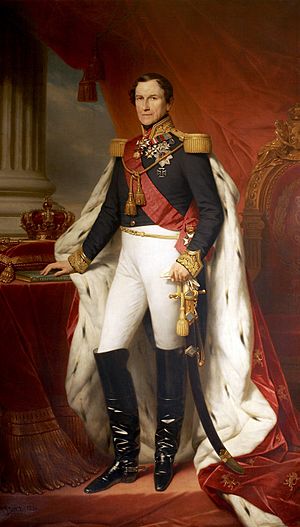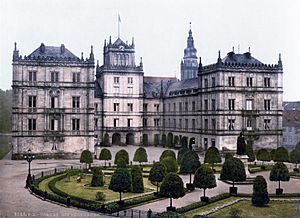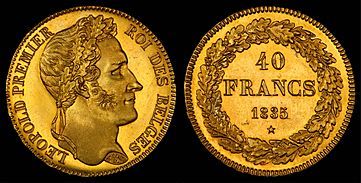Leopold I of Belgium facts for kids
Quick facts for kids Leopold I |
|||||
|---|---|---|---|---|---|

Portrait by Nicaise de Keyser, 1856
|
|||||
| King of the Belgians | |||||
| Reign | 21 July 1831 – 10 December 1865 | ||||
| Predecessor | Erasme Louis Surlet de Chokier (as Regent of Belgium) | ||||
| Successor | Leopold II | ||||
| Prime Ministers |
See list
Joseph Lebeau
Comte de Muelenaere Comte d’Alviella Chevalier de Theux de Meylandt Jean-Baptiste Nothomb Sylvain Van de Weyer Charles Rogier Henri de Brouckère Pierre de Decker |
||||
| Born | 16 December 1790 Ehrenburg Palace, Coburg, Saxe-Coburg-Saalfeld, Holy Roman Empire (modern-day Germany) |
||||
| Died | 10 December 1865 (aged 74) Castle of Laeken, Brussels, Belgium |
||||
| Burial | Church of Our Lady of Laeken | ||||
| Spouse | |||||
| Issue |
|
||||
|
|||||
| House |
|
||||
| Father | Francis, Duke of Saxe-Coburg-Saalfeld | ||||
| Mother | Countess Augusta Reuss of Ebersdorf | ||||
| Religion | Lutheran | ||||
| Signature |  |
||||
| Military career | |||||
| Allegiance | |||||
Leopold I (born December 16, 1790 – died December 10, 1865) was the very first king of the Belgians. He ruled from July 21, 1831, until his death in 1865.
Leopold was the youngest son of Francis, Duke of Saxe-Coburg-Saalfeld. He joined the Imperial Russian Army and fought against Napoleon during the Napoleonic Wars. After Napoleon's defeat, Leopold moved to the United Kingdom. There, he married Princess Charlotte of Wales. She was second in line to the British throne. Sadly, Charlotte died just a year after their marriage. However, Leopold remained an important figure in Britain.
After the Greek War of Independence (1821–1830), Leopold was offered the throne of Greece. He turned it down, thinking it was too risky. Instead, he accepted the throne of Belgium in 1831. This happened after Belgium gained its independence in 1830. The Belgian government chose Leopold because he had good connections with royal families across Europe. Also, Britain supported him, and he wasn't linked to other powerful countries like France. These countries were thought to want Belgian land, which could upset the balance of power in Europe.
Leopold became King of the Belgians on July 21, 1831. This day is now celebrated every year as Belgian National Day. His time as king saw attempts by the Dutch to take Belgium back. Later, there were disagreements between liberals and Catholics within Belgium. Leopold was a Protestant and supported new ideas. He helped create Belgium's first railway in 1835 and encouraged the country's industrial growth. He also managed to slightly increase the king's powers. He played a key role in stopping the Revolutions of 1848 from spreading into Belgium. Leopold died in 1865, and his son, Leopold II, became the next king.
Contents
Early Life and Royal Connections

Leopold was born in Coburg, a small German duchy called Saxe-Coburg-Saalfeld. This area is now part of Bavaria, Germany. His birthday was December 16, 1790. He was the youngest son of Francis, Duke of Saxe-Coburg-Saalfeld, and Countess Augusta of Reuss-Ebersdorf.
Leopold's Military Career
When Leopold was just six years old in 1797, he was given an honorary rank in the Imperial Russian Army. Six years later, he became a Major General.
In 1806, French troops took over Saxe-Coburg during the Napoleonic Wars. Leopold went to Paris and met Napoleon. Napoleon offered him a job, but Leopold said no. Instead, he went to Russia to join the Russian cavalry, which was fighting France. He fought against Napoleon and showed great bravery at the Battle of Kulm. By 1815, when Napoleon was finally defeated, Leopold was a lieutenant general at only 25 years old.
Marriage to Princess Charlotte
Leopold became a British citizen in March 1816. On May 2, 1816, he married Princess Charlotte of Wales in London. Charlotte was the only legitimate child of Prince Regent George (who later became King George IV). This meant she was second in line to the British throne.
The Prince Regent wanted Charlotte to marry William, Prince of Orange. But Charlotte preferred Leopold. Even though the Regent was not happy at first, he found Leopold charming and approved the marriage. Leopold also became a Field Marshal and a Knight of the Order of the Garter.
On November 5, 1817, Princess Charlotte gave birth to a stillborn son. She died the next day from problems after the birth. Leopold was very sad about her death.
If Charlotte had lived, she would have become Queen of the United Kingdom. Leopold would likely have become prince consort, a role later held by his nephew Prince Albert. Even after Charlotte's death, Leopold kept his important status in Britain.
Turning Down the Greek Throne
After the Greek War of Independence, Leopold was offered the throne of an independent Greece in 1830. He was interested at first, but then he decided not to take the offer on May 17, 1830. Later, Otto of Wittelsbach became the King of Greece instead.
Becoming King of Belgium

In August 1830, people in the southern parts of the United Kingdom of the Netherlands (which is now Belgium) rebelled against Dutch rule. This uprising started in Brussels. The rebels pushed back the Dutch army. Other countries met in London and agreed to support Belgium's independence. The Dutch, however, did not want to recognize the new country.
In November 1830, a National Congress was formed in Belgium. Their job was to create a constitution for the new state. They decided that Belgium would be a popular, constitutional monarchy. This meant the king would rule with a constitution that limited his powers.
Finding a Monarch for Belgium
Choosing a king was a very difficult decision. The Congress did not want anyone from the Dutch ruling family. Other powerful countries were worried that choosing a king from another state could cause problems in Europe. They wanted a neutral person.
Eventually, they had a few choices. But all of them were French, and this worried other European powers. Since there was no clear choice, a Belgian nobleman named Erasme Louis Surlet de Chokier was chosen as regent in February 1831. This gave them more time to decide.
Leopold of Saxe-Coburg had been suggested earlier but was put aside due to French opposition. But because of the problems with the French candidates and pressure from other countries, Leopold was considered again. On April 22, a Belgian group officially offered him the throne. Leopold was hesitant to accept at first.
Leopold Becomes King
On July 17, 1831, Leopold traveled from France to Belgium. He was met with great excitement along the way. His official ceremony took place on July 21 in Brussels. Leopold, wearing a Belgian army uniform, swore loyalty to the constitution and became king.
This day, July 21, is now the national holiday in Belgium. It marks the end of the revolution and the start of the Kingdom of Belgium.
Leopold's Reign as King
Securing Belgian Independence
Less than two weeks after Leopold became king, on August 2, the Netherlands invaded Belgium. This was called the Ten Days' Campaign. The small Belgian army was quickly pushed back. Leopold asked France for help. French troops arrived, forcing the Dutch to agree to talks and retreat. Small fights continued for eight years. But in April 1839, both countries signed the Treaty of London. This treaty officially recognized Belgium's independence.
Leopold felt the Constitution gave the king too little power. He tried to increase the monarch's powers where the Constitution was not clear.
Challenges and Progress in Belgium
Leopold I's reign also faced an economic crisis until the late 1850s. After the revolution, the Dutch closed the Scheldt river to Belgian ships. This made the port of Antwerp almost useless. Markets in the Netherlands and its colonies, which were good for Belgian goods before 1830, were closed. The years between 1845 and 1849 were very tough in Flanders. Many people there needed help, and it was a very difficult time. This also caused many people to move to Brussels and industrial areas in Wallonia.
Belgian politics under Leopold I were divided between liberal and Catholic groups. Liberals wanted less church influence and supported free trade. Catholics wanted religious teachings to be important for the state. Leopold, who was a Protestant, often favored the liberals. He supported reforms. In 1842, he tried to pass a law to stop women and children from working in some industries, but it failed. Leopold was an early supporter of railways. Belgium's first railway, between Brussels and Mechelen, was finished in 1835. It was one of the first passenger railways in continental Europe.
Avoiding the 1848 Revolutions
Economic reforms helped Belgium avoid the worst of the Revolutions of 1848 that hit other countries. However, some radical writings appeared in early 1848. The biggest threat came from Belgian groups living in Paris. After the French Revolution of 1848, these Belgian workers were encouraged to return home and overthrow the monarchy. About 6,000 armed Belgians tried to cross the border. The first group was stopped. The second group crossed on March 29 and headed for Brussels. Belgian troops met them at Risquons-Tout. Seven Belgians were killed, and most were captured. To calm things down, Leopold dramatically offered to give up his throne if that was what the Belgian people wanted.
The defeat at Risquons-Tout ended the revolutionary threat to Belgium. The situation improved that summer after a good harvest. New elections brought a strong Liberal majority.
Leopold's Role in Europe

Because of his family connections and Belgium's neutral position, Leopold became an important go-between in European politics. He was nicknamed the "Nestor of Europe," like the wise mediator in Homer's Iliad. Leopold was especially good at helping to keep peace between powerful countries. Later in his reign, he played a key role in managing relations between the United Kingdom and France.
Leopold was also known for arranging royal marriages. In 1835–1836, he helped arrange the marriage between his nephew Ferdinand and the Queen of Portugal, Maria II. He also helped arrange the marriage of his niece, Queen Victoria of the United Kingdom, to his nephew, Prince Albert. Even before she became queen, Leopold advised Victoria through letters.
In foreign policy, Leopold's main goal was to keep Belgium neutral. Despite pressure from powerful countries, especially during the Crimean War (1853–56), Belgium remained neutral.
Leopold's Second Marriage and Children
Leopold married Louise-Marie of Orléans (daughter of Louis Philippe I) on August 9, 1832. They had four children:
- Louis Philippe, Crown Prince of Belgium (1833–1834) who died as a baby.
- Leopold, Duke of Brabant (1835–1909), who became King Leopold II.
- Prince Philippe, Count of Flanders (1837–1905), who was the father of King Albert I of Belgium.
- Princess Charlotte of Belgium (1840–1927). She married Maximilian I of Mexico and became Empress of Mexico.
Queen Louise-Marie died in 1850 at age 38.
Death and the Next King
Leopold died in Laeken, near Brussels, on December 10, 1865. His funeral was held on December 16, which would have been his 75th birthday. He is buried in the Royal Crypt at the Church of Our Lady of Laeken, next to Louise-Marie.
Leopold's son, Leopold II, became the next king at age 30. He ruled until 1909.
Remembering Leopold I
Belgian navy ships have been named in his honor, like the Leopold I frigate. His personal symbol is on the flag of the town of Leopoldsburg. His picture has also appeared on postage stamps and special coins.
Images for kids
-
Leopold on a 40 franc coin from 1835.
See also
 In Spanish: Leopoldo I de Bélgica para niños
In Spanish: Leopoldo I de Bélgica para niños










